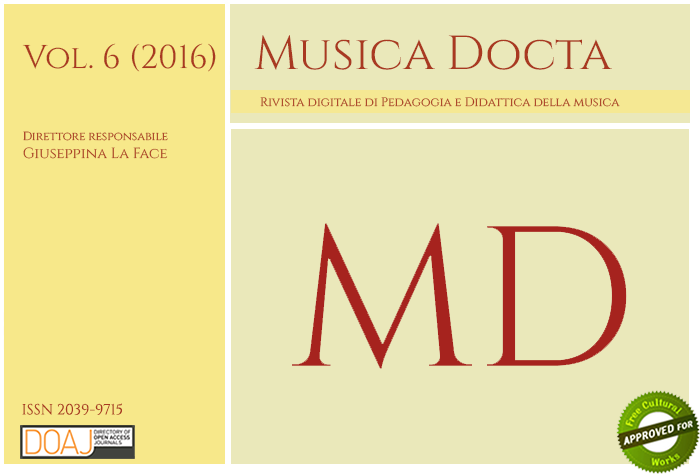ISME and the Twilight of History
DOI:
https://doi.org/10.6092/issn.2039-9715/6565Keywords:
International Society for Music Education, Music history, Listening of musicAbstract
In addition to the International Musicological Society there exists an International Society for Music Education, an association (affiliated with UNESCO) that gathers music educators from over 80 countries. Between the end of the last century and the beginning of the present one, the ISME issued three main policy papers: “Declaration of Beliefs for Worldwide Promotion of Music Education” (1994-96); “Policy on Music Education” (2002); and “Vision and Mission: Leading and Supporting Music Education Worldwide” (2006). A comparative analysis of the three ‘manifestos’ reveals that, while in 1994-96 the ISME explicitly included the triad ‘history – culture – aesthetics’ in its conception, and regarded the ‘listening’ of music as an educationally significant activity, after just a few years the first and third notions (‘history,’ ‘aesthetics’) have all but vanished, and music listening has also disappeared from the agenda. The fact that the notion of ‘history’ and the aesthetic approach to musical art have disappeared from the perspective of music educators worldwide may have to do with scruples about political correctness, motivated by the “Mexico City Declaration on Cultural Policies” of UNESCO (1982), where the notion of ‘culture’ had already replaced that of ‘history’. To be sure, this ignorance, or suspicion, about the historical aspects of music production does not in any way facilitate the task of musicologists (or of ethnomusicologists), nor that of music education teachers.
Downloads
Published
How to Cite
Issue
Section
License
Copyright (c) 2016 Lorenzo Bianconi
The copyrights of all the texts on this journal belong to the respective authors without restrictions.
This journal is licensed under a Creative Commons Attribution Share-Alike 4.0 International License (full legal code).
See also our Open Access Policy.
Metadata
All the metadata of the published material is released in the public domain and may be used by anyone free of charge. This includes references.
Metadata — including references — may be re-used in any medium without prior permission for both not-for-profit and for-profit purposes. We kindly ask users to provide a link to the original metadata record.






